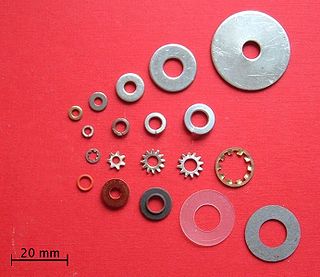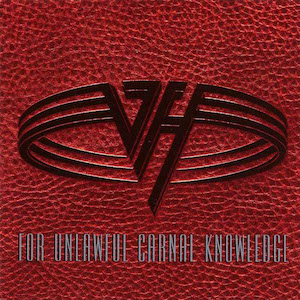
In metallurgy, stainless steel, also known as inox steel or inox from French inoxydable (inoxidizable), is a steel alloy, with highest percentage contents of iron, chromium, and nickel, with a minimum of 10.5% chromium content by mass and a maximum of 1.2% carbon by mass.

Rebar, known when massed as reinforcing steel or reinforcement steel, is a steel bar or mesh of steel wires used as a tension device in reinforced concrete and reinforced masonry structures to strengthen and aid the concrete under tension. Concrete is strong under compression, but has weak tensile strength. Rebar significantly increases the tensile strength of the structure. Rebar's surface is often deformed to promote a better bond with the concrete.
Surgical stainless steel is a grade of stainless steel used in biomedical applications. The most common "surgical steels" are austenitic 316 stainless and martensitic 440 and 420 stainless steels. There is no formal definition on what constitutes a "surgical stainless steel", so product manufacturers and distributors apply the term to refer to any grade of corrosion resistant steel.
John 3:16 is one of the most widely quoted verses from the Bible and has been called the most famous Bible verse. It has also been called the "Gospel in a nutshell", because it is considered a summary of the central theme of traditional Christianity:
For God so loved the world, that he gave his only begotten Son, that whosoever believeth in him shall not perish, but have everlasting life. (KJV)

A washer is a thin plate with a hole that is normally used to distribute the load of a threaded fastener, such as a bolt or nut. Other uses are as a spacer, spring, wear pad, preload indicating device, locking device, and to reduce vibration. Washers often have an outer diameter (OD) about twice their inner diameter (ID), but this can vary quite widely.
In modern Western body piercing, a wide variety of materials are used. Some cannot be autoclaved, and others may induce allergic reactions, or harbour bacteria. Certain countries, such as those belonging to the EU, have legal regulations specifying which materials can be used in new piercings.
Marine grade stainless steel is a misunderstood description. There is no industry recognized definition for a marine grade stainless steel though it is routinely used by many end-users. In a marine environment it must be made clear as to whether the stainless steel is submerged in seawater or is simply near enough to the seashore such that it can be attacked by the chloride present in seawater by splashing or carried by onshore breeze. Chloride ions can cause localized corrosive attack of susceptible stainless steels.
The unified numbering system (UNS) is an alloy designation system widely accepted in North America. It consists of a prefix letter and five digits designating a material composition. For example, a prefix of S indicates stainless steel alloys, C indicates copper, brass, or bronze alloys, T indicates tool steels, and so on. The first 3 digits often match older 3-digit numbering systems, while the last 2 digits indicate more modern variations. For example, Stainless Steel Type 310 in the original 3-digit system became S31000 in the UNS System. The more modern low-carbon variation, Type 310S, became S31008 in the UNS System. Often, the suffix digit is chosen to represent a material property specification. For example, "08" was assigned to UNS S31008 because the maximum allowed carbon content is 0.08%. The UNS is managed jointly by the ASTM International and SAE International. A UNS number alone does not constitute a full material specification because it establishes no requirements for material properties, heat treatment, form, or quality.

Austenitic stainless steel is a specific type of stainless steel alloy. Stainless steels may be classified by their crystalline structure into four main types: austenitic, ferritic, martensitic and duplex. These stainless steels possess austenite as their primary crystalline structure. This austenite crystalline structure is achieved by sufficient additions of the austenite stabilizing elements nickel, manganese and nitrogen. Due to their crystalline structure austenitic steels are not hardenable by heat treatment and are essentially non-magnetic.

The SAE steel grades system is a standard alloy numbering systems for steel grades maintained by SAE International.
41xx steel is a family of SAE steel grades, as specified by the Society of Automotive Engineers (SAE). Alloying elements include chromium and molybdenum, and as a result these materials are often informally referred to as chromoly steel. They have an excellent strength to weight ratio and are considerably stronger and harder than standard 1020 steel, but are not easily welded.

Cable railings or wire rope railings are safety rails that use horizontal or vertical cables in place of spindles, glass and mesh for infill.
SAE 304 stainless steel is the most common stainless steel. The steel contains both chromium and nickel [1] metals as the main non-iron constituents. It is an austenitic stainless steel. It is less electrically and thermally conductive than carbon steel and is essentially non-magnetic. It has a higher corrosion resistance than regular steel and is widely used because of the ease in which it is formed into various shapes.
SAE type 630 stainless steel is a grade of martensitic precipitation-hardened stainless steel. It contains approximately 15–17.5% (17) chromium and 3–5% (4) nickel, as well as 3–5% copper.
SAE 316L grade stainless steel is the second most common austenitic stainless steel after 304. Its primary alloying constituents after iron, are chromium, nickel (10–12%) and molybdenum (2–3%). The addition of molybdenum provides greater corrosion resistance than 304, with respect to localized corrosive attack by chlorides and to general corrosion by reducing acids, such as sulphuric acid. 316L grade is the low carbon version of 316 stainless steel.
ASTM A193/A193M is a specification from the ASTM International that primarily govern industrial piping applications. In the assembly of an industrial plant, many complex components are bolted together of which include parts such as valves, piping, and pressure vessels. ASTM A193 defines the methodology to procure and certify externally threaded fasteners according to specific chemical and mechanical criteria. It is standards such as this that allow industrial process applications to be safely engineered so they do not exceed the tensile strength of the fasteners that hold them together.









